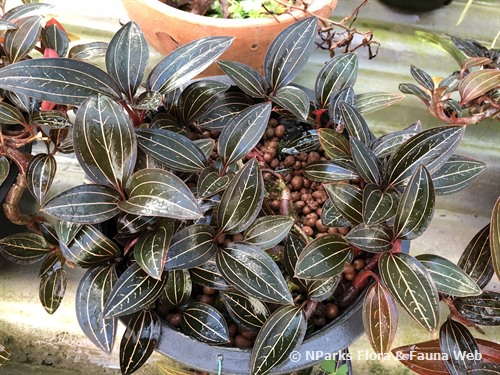
Back
Ludisia discolor (Ker Gawl.) A. Rich.
| Family Name: | Orchidaceae |
| Synonyms: | Haemaria discolor |
| Common Name: | Jewel Orchid, Black Jewel Orchid, Jewelled Ludisia, 血叶兰 |
Jewel Orchid, Ludisia discolor is known more for its velvety leaves of brownish to olive green, marked with white to pink veins and reddish undersides. This herbaceous plant grows well as indoor plant under partial light on well-drained, moist soil.
Name
Classifications and Characteristics
| Plant Division | Angiosperms (Flowering Seed Plants) (Monocotyledon) |
|---|---|
| Plant Growth Form | Herbaceous Plant |
| Lifespan (in Singapore) | Perennial |
| Mode of Nutrition | Autotrophic |
| Plant Shape | Shrubby |
| Maximum Height | 1 cm to 6 cm |
| Maximum Plant Spread / Crown Width | 1 cm to 4.5 cm |
Biogeography
| Native Distribution | South-Central and Southeast China, Myanmar, Thailand, Cambodia, Laos, Vietnam, Peninsular Malaysia, Borneo, Philippines, Sumatra. |
|---|---|
| Native Habitat | Terrestrial (Primary Rainforest, Riverine) |
| Preferred Climate Zone | Tropical, Sub-Tropical / Monsoonal |
| Local Conservation Status | Non-native (Horticultural / Cultivated Only) |
| CITES Protection | True (Appendix II) |
Description and Ethnobotany
| Growth Form | Terrestrial orchid with erect growth habit. |
|---|---|
| Foliage | Brownish to olive green leaves (5 - 8 cm long) have whitish to pinkish venation and reddish underside. Velvety leaves are narrowly ovate to elliptic with entire leaf margin. |
| Flowers | Small, fragrant flowers are white with yellow center. They are arranged in spike inflorescences borne on long stalks (30 cm long). |
| Fruit | Fruits are seed pods. |
| Cultivation | This orchid is easy-to-grow. It should be planted in fertile, well-drained, but moist soil (eg., potting mix for African violets or a mixture of fine bark, coconut peat and isolite). Plants grow well in partial shade to shade (85 - 90%). It prefers moist air, so place potted plants next to other plants to increase humidity. Avoid overwatering which leads to root rot. Propagate by stem cuttings. Stems placed in water will root after several weeks and even bloom. |
| Etymology | The species epithet "discolor" means that the plant is composed of 2 different colours. |
Landscaping Features
| Landscaping | This species is grown for its ornamental foliage which have striking venation. It is suitable as an indoor plant and grows well in terrariums. |
|---|---|
| Desirable Plant Features | Ornamental Foliage |
| Landscape Uses | Container Planting, Focal Plant, Terrarium, Interiorscape/ Indoor Plant |
Fauna, Pollination and Dispersal
| Seed or Spore Dispersal | Abiotic |
|---|
Plant Care and Propagation
| Light Preference | Semi-Shade, Full Shade |
|---|---|
| Water Preference | Moderate Water |
| Plant Growth Rate | Moderate |
| Rootzone Tolerance | Moist Soils, Well-Drained Soils |
| Pest(s) | Chewing Insects, Sucking Insects |
| Propagation Method | Division |
Foliar
| Foliage Retention | Evergreen |
|---|---|
| Mature Foliage Colour(s) | Brown, Green, Red |
| Mature Foliage Texture(s) | Velvety / Furry / Tomentose, Thick |
| Prominent Young Flush Colour(s) | Brown, Red |
| Young Flush Texture(s) | Smooth |
| Foliar Type | Simple / Unifoliate |
| Foliar Arrangement Along Stem | Spiral |
| Foliar Attachment to Stem | Petiolate |
| Foliar Shape(s) | Non-Palm Foliage (Oval) |
| Foliar Venation | Pinnate / Net |
| Foliar Margin | Entire |
| Foliar Apex - Tip | Acute |
| Foliar Base | Rounded / Obtuse |
| Typical Foliar Area | Notophyll ( 20.25cm2 - 45 cm2 ) |
| Leaf Area Index (LAI) for Green Plot Ratio | 3.5 (Shrub & Groundcover - Monocot) |
Non - Foliar and Storage
| Stem Type & Modification | Herbaceous |
|---|---|
| Root Type | Underground (Fibrous Root) |
Floral (Angiosperm)
| Flower & Plant Sexuality | Bisexual Flowers |
| Flower Colour(s) | White |
|---|---|
| Flower Texture(s) | Smooth |
| Flower Grouping | Cluster / Inflorescence |
| Flower Location | Axillary |
| Individual Flower Shape | Labiate / Lipped |
| Flowering Period | Free-Flowering, A Few Times Yearly |
| Flowering Habit | Polycarpic |
Fruit, Seed and Spore
| Fruit Classification | Simple Fruit |
|---|---|
| Fruit Type | Dehiscent Dry Fruit |
Image Repository
Others
| Master ID | 908 |
|---|---|
| Species ID | 2202 |
| Flora Disclaimer | The information in this website has been compiled from reliable sources, such as reference works on medicinal plants. It is not a substitute for medical advice or treatment and NParks does not purport to provide any medical advice. Readers should always consult his/her physician before using or consuming a plant for medicinal purposes. |

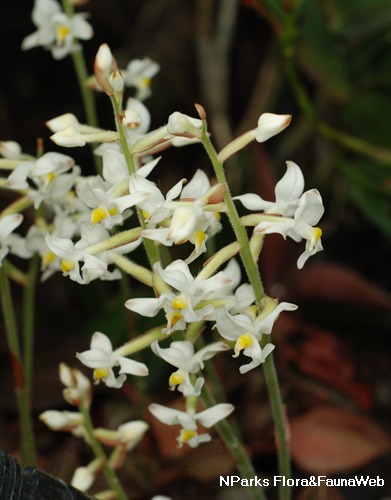
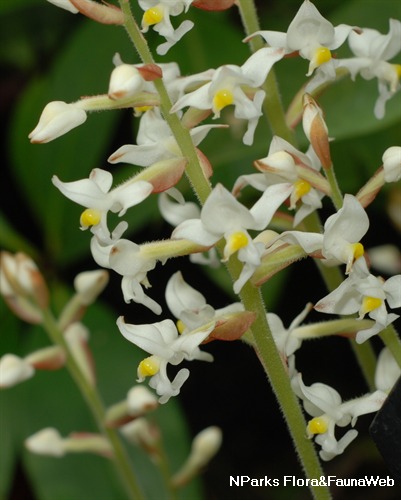
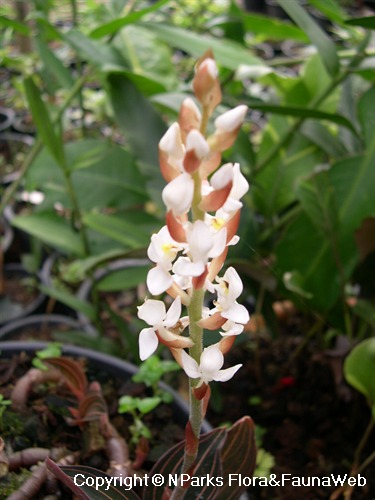
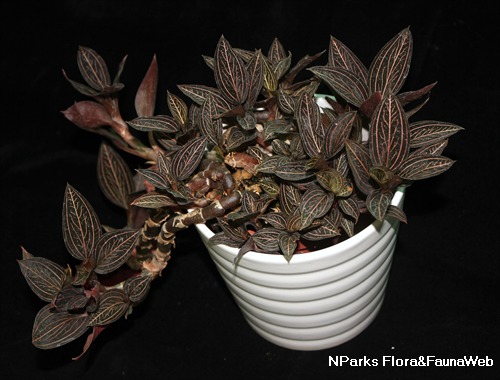
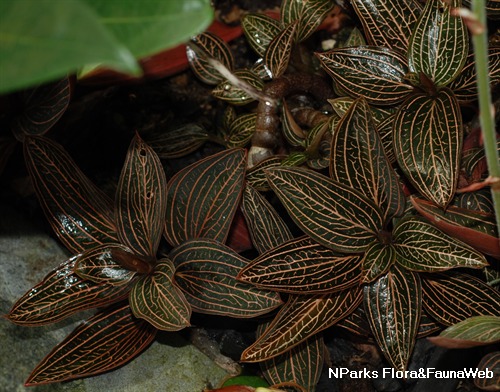
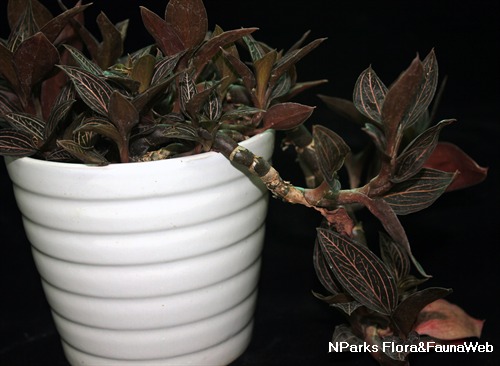
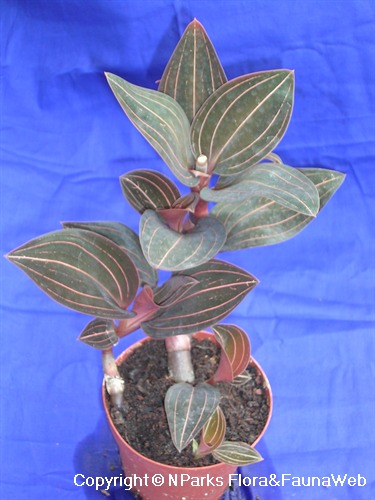
.jpg)